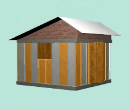Three decades of disaster prevention that works
It is a long hard road until construction projects integrate disaster prevention into their project planning. It is the dream of EcoSouth to influence development projects in this direction, prior to the onslaught of catastrophes.

To build dwellings that withstand local climatic conditions has been a guiding principle in the housing projects of EcoSouth partners over the past three decades. From Columbia, to the Dominican Republic, to Nicaragua, Jamaica, Cuba, houses have withstood recurring hurricanes or earth tremors. This has given EcoSouth the confidence to continue this path.
A 2001 study of a post-earthquake adobe reconstruction project in Guatemala after the disastrous 1976 earthquake reveals that the solid and attractive houses have withstood the recurring tremors.

A couple of violent Caribbean storms demonstrated the resistance of Micro Concrete Roofing (MCR) tiles. After Hurricane George ravaged the Dominican Republic in 1998, EcoSouth partners from Honduras and Ecuador quickly went to asses several housing projects built by the local partner and discovered that the MCR roofs had not been blown away by the force of the wind. This confirmed the experiences after Hurricane Gilbert tore through Jamaica in 1988 when the only building to have a roof in a neighbourhood was the Old Age Home roofed with MCR tiles. It became a local shelter after the storm. Similar examples throughout the region are evident where EcoSouth partners have been active over the years.
In fact, the hurricane laden Caribbean has demonstrated the resistance of Micro Concrete Roofing tiles (MCR), as well as other technologies including vaulted brick roofs. In a sense it is a laboratory for hurricane resistant construction!

Post-disaster response after the devastating Hurricane Mitch in 1998 is a vivid example of synergies among EcoSouth partners in reconstruction in Honduras and Nicaragua. In both countries, relocation plans and designs were carried out on site by a team from EcoSouth partner CIDEM, and the projects implemented by Honduras partner EcoVide and Nicaraguan partner Sofonic.
Education is the key element in preventing disasters. EcoSouth focuses upon a process of participatory design as well as on-site building instruction, so that people will understand risks and how to use construction materials.
Over the years EcoSouth has been able to observe the behavior of EcoMaterials in these extreme situations. The accompanying summaries (link) highlight experiences using technologies and materials that have withstood recurring disasters.




